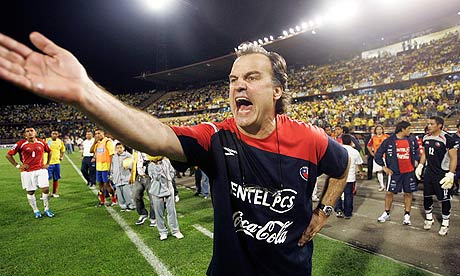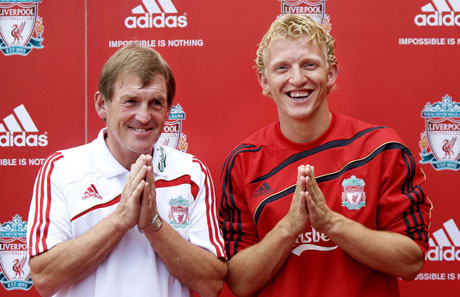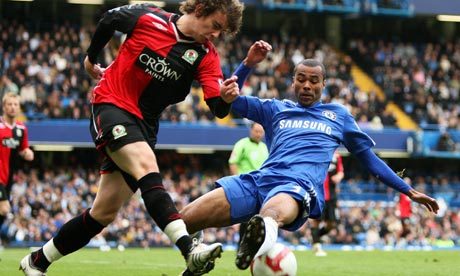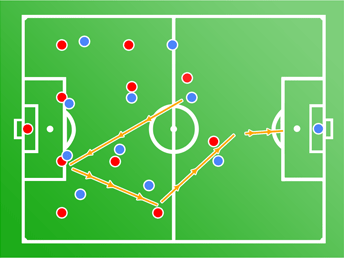-
Recent Articles
The Midfielder as Centerback
 Marcelo Biesla and Josep Guardiola are both managers who play a very high line with their respective sides and who both demand that all players be technically proficient with the ball. Part of playing...
Marcelo Biesla and Josep Guardiola are both managers who play a very high line with their respective sides and who both demand that all players be technically proficient with the ball. Part of playing...Understanding the 4-4-2 Diamond
DEFENCE Despite the fact that there are four ways to play a diamond formation on FM, the differences between them are few and usually subtle. As a starting point, one thing each of them do have...3 at the back and the 4-4-2 Diamond
 Last week Chelsea v Liverpool became the biggest tactical talking point of the season. Liverpool revived the the 3 man defence that Kenny debuted against Stoke. While with the introduction of Torres for £50m...
Last week Chelsea v Liverpool became the biggest tactical talking point of the season. Liverpool revived the the 3 man defence that Kenny debuted against Stoke. While with the introduction of Torres for £50m...How To Set Up A Back Four
 Last year, I wrote a guide about how to play a simple 4-4-2. One of the major components of that is the back four. In fact, most modern formations build upon four defenders; two full backs and two centre...
Last year, I wrote a guide about how to play a simple 4-4-2. One of the major components of that is the back four. In fact, most modern formations build upon four defenders; two full backs and two centre...Building Your Defence: Full Backs
 The modern full back is quickly becoming one of the most important players on the team sheet, infact even back in the days of Brian Clough, fat ed' argued that because of the space these players get in the final...
The modern full back is quickly becoming one of the most important players on the team sheet, infact even back in the days of Brian Clough, fat ed' argued that because of the space these players get in the final...
JOIN 1,231 READERS - SUBSCRIBE NOW TO OUR FOOTBALL MANAGER NEWSLETTER
Get the latest FM news & best community content delivered directly to your e-mail inbox!
Tactical Bible ’08: Tactic Building Approaches: A Reference Guide
Written by: Matt vom Brocke
Category: Strategy
Posted on: May 29, 2007
May 29, 2007
Tactic Building Approaches, a reference guide
Helpful basic tweaks for building tactic sets
This reference guide should help to give you a starting point if you want to design tactic sets with several tactical approaches for different situations. Every approach is portrayed with a few key settings that should be changed. It is up to you to apply all of the suggested settings or only parts of them, depending on the needs of your formation and team.
Please use this guide simply as a ‘how-to’, resource and reference if needed. There is not much elaboration of the theories and ideas as usual for tactical bible articles. The most important background articles are linked at the end.
The suggested approaches follow two models: the ‘classic’ model we presented in ‘Analysing AI tactical systems’ and an alternate model presented in wwfan’s article ‘How to play FM’.
Please use these suggestions as rules of thumb, since they may need slight adaptation for different formations. They should work for most formations and mindsets, RoO, RoT, global and split.
Overview:
Classic model:
1 Defensive
2 Balanced
3 Attack away
4 Attack home
5 Control
Alternate model:
1 Defend
2 Counter
3 Possession
4 Attack
5 Control
Both models offer a variety of slightly different solutions, which will meet finally at the Control approach used against ultra-defensive, time wasting opposition. In addition they can be extended with ‘special’ formations like a kill-game/shut-up-shop and overloading formations.
The ‘classic’ model
(As presented in ‘Analysing AI tactical systems’)
Defensive approach:
If using RoO/global mindsets, you have to make a choice first. Do you want to use a defensive mentality which will lead to a slightly ‘destructive’ approach, aiming at destroying the opposition’s play or do you want to play carefully (and maybe possession oriented) but higher up the pitch and aim at going for your own chances from a very solid back. In this case you should choose the ‘attack away’ mindset.
Last efforts have shown that in most cases the latter approach seems to be more promising.
Please note: RoT and split mentality systems will not be affected by this or only have to do minor changes.
D-line: deep. From about 3 to 8. Please not that top teams can play slightly higher while smaller teams, especially with slow defenders should stay deeper.
Time wasting: high (around 15).
Width: if you don’t link passing and width, a narrow setup can be very helpful.
Counter attack: this is a long discussion if you want to succeed on the counter or keep the ball for a very patient build up play. Both efforts can succeed, if the settings are right.
Possession approach: reduce TTB across the team, but crossed often on the wings
Forward runs: maybe the most important settings for a defensive approach.
Full backs: If playing 4-4-2 or diamond: rarely. Mixed can work if you are using two DMCs. Many players always prefer to keep their fullbacks on mixed, but keeping them back can have a huge effect on your defensive stability.
Wingers: rarely if you want to stay in a ‘destructive’ mode, mixed if you play possession football and look for chances out of the midfield.
Marking: even the midfield should be set completely to tight marking, or tight man marking if you are preferring a man-marking system.
Closing down: Most likely you will want to have high closing down in midfield and attack, as well for the fullbacks to prevent being bombed with crosses (which would mean closing down for fullbacks from 9-13).
Balanced approach:
The balanced approach aims at controlling the game higher up the pitch, again from a solid defence, but the defensive players now will as well support the attack (especially the fullbacks), while the midfield still fulfils defensive duties as well.
D-line: higher up the pitch, deep enough though not to get exposed too much. Please consider the same issues as above. A normal range would be from 6-9.
Time wasting: less then defensive, but still enough to give you team time with the ball and slow the game down if you are already leading. This would mean about 10 to 14.
Forward runs: Fullbacks and wingers mixed.
Marking: the wingers and DMC or MC/d should stay on tight marking-
Closing down: If you aim at possession, closing down should stay high, if you aim at keeping your shape and launching fast counters, it can be lowered.
Through balls: if you want to exploit a large number of fast counters, they should be increased (mixed for DMCs/MCds and FBs, often for wingers and AMCs/MC/as).
Counter attack: normally it should be very helpful for a balanced approach to exploit counter chances, unless you are aiming at a consequent possession football.
Attacking approaches
Both approaches, attack away and attack, will clearly try to dominate the game high up the pitch, with an active support from the defensive players as well. If constructed well, the attack away approach will offer a few more security options and often suited as a home attack against stronger opponents as well.
Attack away approach
D-line: higher up the pitch, ideally about 8 to 11.
Time wasting: from mixed (11) downwards to about 8 or 7.
Forward runs: Fullbacks mixed (sometimes even rarely if you want a very tight defense, but the build up play might suffer), wingers often, in a very aggressive version fullbacks often (but a security measure like a pure DMC will be needed).
Marking: the whole midfield could be set to normal marking, the DMC to tight or normal.
Closing down: since you are intending to play high up the pitch, a higher closing down could be very helpful. Again, if looking for loads of counter chances, it can be lowered.
Through balls: if you want to exploit a large number of fast counters, they should be increased (mixed for DMCs/MCds and FBs, often for wingers and AMCs/MC/as).
Counter attack: normally it should be very helpful as well to exploit counter chances, even if attacking away. Unless you are playing very defensive underdogs, you should keep this option.
Crosses from: wingers mixed, fullbacks deep or mixed if you intend to use them for increasing the pressure heavily.
Attack home approach:
If using RoO or global mentality, you will want to switch to the most attacking framework now.
D-line: can be very high (around 13-15)
Time wasting: very low (around 5) Please note: it can be worth increasing time wasting slightly because the combination of very high mentality and very low time wasting can lead to too many rushed passes and shots off target or chances of low quality.
Forward runs: Fullbacks mixed or often (very aggressive), wingers often.
Marking: the complete midfield (maybe even the DMC) could stay on loose (zonal) marking. There are also some reports of keeping the back four on loose zonal marking successfully.
Closing down: The very aggressive version would be very high closing down, but it is possible as well to keep it lower since you will keep the opposition in their own half most of the time. Opposition instructions on defensive players might increase the pressure.
Through balls can be kept as above.
Counter attack: recommended against equal and stronger teams.
Crosses from: wingers from byline, fullbacks mixed.
The kill game/shut up shop and overloading approaches will be presented in separate topics.
Alternate model:
This is a model of approaches which will slightly differ, introduced by wwfan with presenting the 2.0 versions of his RoO tactics. You will note that the basic model is the same, while the approaches and solutions differ. This is another example of the variety of possible approaches, based on your preferred style of play, formation and preferences.
The Control approach will look very similar for both models.
Standard Systems within One Formation (4-4-2)
Defend
Defensive mentality
Narrow width
Deep defensive line
Easy tackling
Rarely closing down
Tight marking
Slow tempo
Heavy Time Wasting
Minimal Forward Runs
No Free Roles
Few Through Balls
Low Creative Freedom
No Farrows on Wingers
Counter
Defensive/Normal mentality
Medium/Narrow width
Medium/Deep defensive line
Easy tackling
Rarely closing down
Tight marking
Slow tempo
Medium Time Wasting
Wide Players and Forwards Make Forward Runs
One/Two Free Roles
MCs play Through Balls
Low Creative Freedom
Short Farrows on Wingers
Possession
Normal/Attacking mentality
Medium width
Medium defensive line
Normal/Heavy tackling
Medium closing down
Loose/Tight marking
Medium tempo
Medium Time Wasting
All players except DCs and MCd make mixed/often forward runs
Two Free Roles
All players play Mixed Through Balls
Low/Normal Creative Freedom
Short Farrows on Wingers
Attack
Attacking mentality
Wide width
High defensive line
Hard tackling
Often closing down
Loose marking
High tempo
Low Time Wasting
All players except DCs/MCd make forward runs often
Three/Four Free Roles
All players play Often Through Balls
Offside Trap
Attackers/Wingers Hold Up Ball
Wingers High Creative Freedom/MCa/FCs Normal
Long Farrows on Wingers
Control
Attacking mentality
Ultra-wide width
Medium defensive line
Hard tackling
Often closing down
Loose marking
Slow tempo
Low Time Wasting
All players except DCs/MCd make forward runs often
Three/Four Free Roles
All players play Often Through Balls
Offside Trap
Attackers/Wingers Hold Up Ball
Wingers High Creative Freedom/MCa/FCs Normal
Long Farrows on Wingers
Tweaking example: how to adapt a Control approach to a different formation, in this case a 4-2-3-1 using RoT.
No counter attack
High defensive line
Offside trap
Slow tempo
Mixed/Low time wasting (8-11)
Reduced (mixed) forward runs of fullbacks
Through balls reduced (mixed) for every player except AMC/FC (often)
Long shots mixed for all midfielders/forwards
Increased closing down in centre (MCs, AMC, FC)
TMS supply feet (or head) instead of run to ball.
These tweaks are needed since there is only one striker up front who might run after through balls all day long without reaching them. The team will use a possession oriented build up play around the deep sitting opposition while waiting patiently to play the final pass or shoot from distance. The high line will ensure an aggressive ball winning defence which keeps the formation compact and pressure high.
Helpful links
Analysing AI tactical systems - Introduction of the ‘classic’ approaches
Tactical Design and Management Strategy - Introduction of the new approaches
Tactical Bible Credits:
JP, garyh, The Next Diaby, wwfan, Millie
About The Author: Matt vom Brocke
Matt’s contribution to FM-B as a whole and the tactical area in particular cannot be over-estimated. The writer of the very well-recieved Communication and Psychological Warfare and Creativo set of tactics, Matt is a key member of the Tactical Think Tank and part of SI’s beta testing Dream Team.
Download Our Tactical Theorems '10 eBook Absolutely Free

Presenting the most comprehensive tactic design and match strategy guide to the Football Manager series ever created!
Written by FM match engine beta testers, it's 60+ pages of easy-to-read concepts and ideologies for getting your team playing exactly how you want each match! It's been downloaded over 100,000+ times to date!
Find out more information about our tactical eBook
and download Tactical Theorems '10 right now!
Written by FM match engine beta testers, it's 60+ pages of easy-to-read concepts and ideologies for getting your team playing exactly how you want each match! It's been downloaded over 100,000+ times to date!
and download Tactical Theorems '10 right now!




